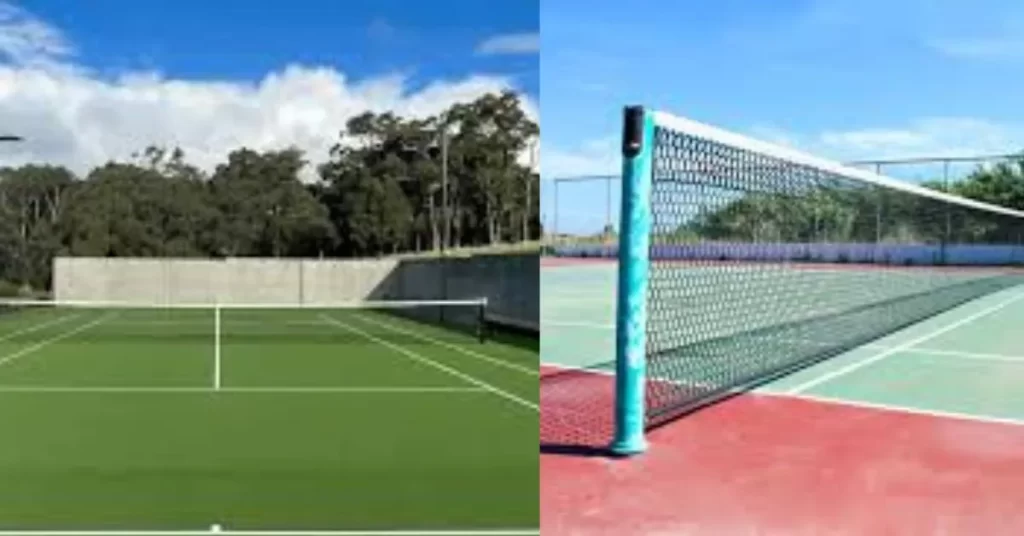
Pickleball is one of the fastest-growing sports in the United States. Originally invented in 1965 as a children’s backyard game, pickleball has evolved into a popular sport for all ages. The game combines elements of tennis, badminton, and ping pong. Converting your tennis court into pickleball tennis court is an excellent way to adapt to the growing popularity of this sport. Played on a badminton-sized court with a tennis-style net, pickleball uses solid paddles to hit a perforated plastic ball over the net. The game can be played in singles or doubles.
With the rising popularity of pickleball, many tennis facilities are looking to convert existing tennis courts into dedicated pickleball tennis courts or into dual tennis and pickleball courts. Converting your tennis court into pickleball tennis courts is an excellent way to expand your offerings and attract new players. Here is what you need to know about pickleball court size, layout, and conversion options.
Pickleball Tennis Court Size
Chapters
ToggleA regulation pickleball court is 20 feet wide by 44 feet long – about a quarter the size of a tennis court. The net height is 36 inches at the sidelines and 34 inches in the middle. Courts are striped similar to a tennis court with a non-volley zone extending 7 feet back from the net on each side.
Pickleball tennis court conversion kits are available that provide portable nets, boundary lines, and court numbers to temporarily convert tennis courts to pickleball. These conversion kits allow the same space to be used for either tennis or pickleball as needed.
Permanent pickleball court lines can also be painted onto your existing tennis courts. When laying out permanent pickleball courts on a tennis court, the most common configurations are:
- 2 pickleball courts side-by-side across a 36’ wide tennis court
- 3 pickleball courts on a 60’ wide tennis court
- 4 pickleball courts on a 78’ wide tennis court
Pickleball Tennis Court Design
When converting tennis courts into dedicated pickleball courts, there are several design factors to consider:
- Permanent vs portable nets – Permanent nets allow for easy ongoing use but reduce flexibility. Portable nets provide the option to switch between sports.
- Blended lines vs single sport – Blended line courts have both tennis and pickleball lines which allows for multi-sport use. Single sport courts are less visually confusing.
- Surfacing – New pickleball courts use a textured, non-skid surface that helps control ball bounce. Applying texture acrylic resurfacing to existing tennis courts can optimize them for pickleball.
- Fencing – Ball containment fencing behind baselines may be needed if adjacent to roads or buildings. Windscreens can also help control errant balls.
- Lighting – Proper lighting ensures courts are playable at night. LED lights save energy and provide better visibility.
- Accessories – Benches, ball holders, shade structures, and storage can improve the player experience.
No matter what configuration you choose, it’s relatively fast and affordable to convert existing tennis courts into pickleball courts. With some line adjustments, net placement, and surface optimization you can create courts ready for this exciting paddle sport. Reach out to a reputable court surfacing company for guidance on the best options for your facility.
How Many Pickleball Courts Fit on a Tennis Court?
Here are some of the most common options for converting tennis court to pickleball:
- Convert 2 tennis courts into 8 pickleball courts
- Convert 1 tennis court into 4 pickleball courts
- Convert 2 tennis courts into 6 pickleball courts + 1 tennis court
- Convert 3 tennis courts into 10 pickleball courts + 1 tennis court
- Convert 3 tennis courts into 12 pickleball courts
The ideal layout will depend on the demand for each sport at your facility, along with space constraints. Many facilities find that converting 2-3 tennis courts into 6+ dedicated pickleball courts allows them to meet the needs of most players. Converting your tennis court into a pickleball tennis court is an exciting venture. Supplementary portable nets can provide added flexibility to alternate between tennis and pickleball on a single court as needed.
With the adaptability of existing tennis courts, you can design the perfect layout to accommodate the growth of pickleball while still providing tennis courts for your community. Converting to pickleball is an affordable way to expand your programming, draw in more players, and maximize your outdoor recreation space.
The Future of Pickleball
In many communities, there are more people wanting to play pickleball than there are available courts. As participation continues rising, pickleball advocates are pushing for more dedicated facilities. Converting underutilized tennis courts is an affordable solution for cost-conscious parks and recreation departments looking to expand pickleball capacity. The portability of pickleball makes it easy to share court space.
Look for pickleball to become a standard feature in public parks, schools, community centers, apartment complexes, and planned retirement communities. The USA Pickleball Association offers resources to help communities meet the demand for more pickleball courts and capitalize on the social, health, and economic benefits of this flourishing sport.
FAQs
A: While it’s possible to convert your tennis court yourself, professional assistance ensures a high-quality conversion that meets all standards.
A: A standard pickleball court is 20 feet wide and 44 feet long for singles and 20 feet wide and 22 feet long for doubles.
A: You may need to adjust or add fencing to ensure the court complies with pickleball regulations.
A: In most cases, you can use the existing surface with proper resurfacing and court line painting.
A: The time required depends on various factors, but with professional help, it can typically be done within a few weeks.
Sharing is caring!

Comments are closed.